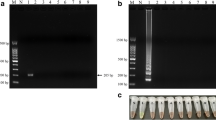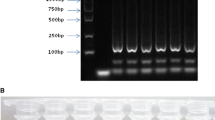Abstract
Mango (Mangifera indica) is one of the most popular tropical fruits around the world. It is also widely and commonly used in many cuisines and products in the food industry. However, the anaphylactic reaction caused by mango has long been reported as a major problem for consumption in recent years. To prevent allergens in mango, the best way is to avoid mango in the diet. In this study, a loop-mediated isothermal amplification (LAMP) assay was developed for the detection of mango in food. Four specifically designed LAMP primers targeting the internal transcribed sequence 1 (ITS1) of nuclear ribosomal DNA sequence regions were used to address the LAMP reaction for amplifying mango DNA. The results demonstrated that the detection of mango DNA was specifically validated by the LAMP primer. The sensitivity of LAMP for detecting mango DNA is equivalent to that of the traditional PCR method. The LAMP primer sets showed high specificity for detecting the DNA of mango and had no cross-reactions to other species. Moreover, when mango was mixed with other fruits at different ratios, no cross-reactivity for the detection of mango DNA was manifested during LAMP. Finally, genomic DNAs extracted from different heat-processed mangos were used as templates; the detection of mango DNA by LAMP was not significantly affected and was reproducible. As to this established LAMP herein, mango ingredients can be detected, and commercial foods containing mango can also be identified. This assay will be useful and have potential for the rapid detection of mango DNA in practical food markets.







Similar content being viewed by others
References
Nutrient profile for mango from USDA SR-21, Available at https://nutritiondata.self.com/facts/fruits-and-fruit-juices/1952/2.
McGovern TW, LaWarre S (2001) Botanical briefs: the mango tree—Mangifera indica L. Cutis 67:365–366
Wu TC, Tsai TC, Huang CF, Chang FY, Lin CC, Huang IF, Chu CH, Lau BH, Wu L, Peng HJ, Tang RB (2012) Prevalence of food allergy in Taiwan: a questionnaire-based survey. Intern Med J 42:1310–1315
Hegde L, Venkatesh YP (2007) Anaphylaxis following ingestion of mango fruit. J Investig Allergol Clin Immunol 17:341–344
Food Standards Agency (2005) Draft of guidance on allergen management and consumer information. Available at http://www.reading.ac.uk/foodlaw/pdf/uk-05052-allergens.pdf
Shah A, Gera K (2014) Immediate hypersensitivity reaction with mango. Pneumonol Alergol Pol 82:445–453
Fasoli E, Righetti PG (2013) The peel and pulp of mango fruit: a proteomic samba. Biochim Biophys Acta 1834:2539–2545
Paschke A, Kinder ZK, Wigotzki M, Weßbecher R, Vieluf D, Steinhart H (2001) Characterization of allergens in mango fruit and ripening dependence of the allergenic potency. Food Agric Immunol 13:51–61
Andrade J, DeMagalhães T, Torres Toledo S, Beserra Nogueira BR, Cordenunsi FM, Lajolo ODN Jr (2012) 2D-DIGE analysis of mango (Mangifera indica L.) fruit reveals major proteomic changes associated with ripening. J Proteom 75:3331–3341
Renuse S, Harsha HC, Kumar P, Acharya PK, Sharma J, Goel, R, Kumar GS, Raju R, Prasad TS, Slotta T, Pandey A (2012) Proteomic analysis of an unsequenced plant—Mangifera indica. J Proteom 75:5793–5796
Besler M, Paschke A, Rodriguez J (2001) Allergen data collection: mango (Mangifera indica). Internet Symp Food Allerg 3:135–141
Vargas Correa JB, Sánchez Solís L, Farfán Ale JA, Noguchi H, Moguel Baños MT (1991) Vargas de la Peña, M.I. Allergological study of pollen of mango (Magnifera indica) and cross reactivity with pollen of piru (Schinus molle). Rev Alerg 38:134–138
Wellhausen A, Schöning B, Petersen A, Vieths S (1996) IgE binding to a new cross-reactive structure: a 35 kDa protein in birch pollen, exotic fruit and other plant foods. Z Ernahrungswiss 35:348–355
Song J, Zhang H, Liu Z, Ran P (2008) Mango profiling: cloning, expression and cross-reactivity with birch pollen profiling Bet v2. Mol Boil Rep 35:231–237
Srivastava N, Bajpai A, Chandra R, Rajan S, Muthukumar M, Srivastava MK (2012) Comparison of PCR based marker systems for genetic analysis in different cultivars of mango. J Environ Biol 33:159–166
Mansour H, Mekki LE, Hussein MA (2014) Assessment of genetic diversity and relationships among Egyptian mango (Mangifera indica L.) cultivers grown in Suez Canal and Sinai region using RAPD markers. Pak J Biol Sci 17:56–61
Souza IG, Valente SE, Britto FB, de Souza VA, Lima PS (2011) RAPD analysis of the genetic diversity of mango (Mangifera indica) germplasm in Brazil. Genet Mol Res 10:3080–3089
Notomi T, Okayama H, Masubuchi H, Yonekawa T, Watanabe K, Amino N, Hase T (2000) Loop-mediated isothermal amplification of DNA. Nucleic Acids Res 28:e63
Huang CH, Lai GH, Lee MS, Lin WH, Lien YY, Hsueh SC, Kao JY, Chang WT, Lu TC, Lin WN, Chen HJ, Lee MS (2010) Development and evaluation of a loop-mediated isothermal amplification assay for rapid detection of chicken anaemia virus. J Appl Microbiol 108:917–924
Woźniakowski G, Tarasiuk K (2015) Visual detection of goose haemorrhagic polyomavirus in geese and ducks by loop-mediated isothermal amplification. Avian Pathol 44:311–318
Chen HJ, Lee MS, Lai JY, Lai GH (2015) Development of a loop-mediated isothermal amplification method for the rapid detection of the dioxin-degrading bacterium Ochrobactrum anthropi in soil. J Environ Manage 160:263–270
Lee MS, Huang JY, Lien YY, Sheu SC (2019) The rapid and sensitive detection of edible bird's nest (Aerodramus fuciphagus) in processed food by a loop-mediated isothermal amplification (LAMP) assay. J. Food Drug Anal 27:154–163
Lai GH, Chao J, Lin MK, Chang WT, Peng WH, Sun FC, Lee MS, Lee MS (2015) Rapid and sensitive identification of the herbal tea ingredient Taraxacum formosanum using loop-mediated isothermal amplification. Int J Mol Sci 16:1562–1575
Lee MS, Su TY, Lien YY, Sheu SC (2017) The development of loop-mediated isothermal amplification (LAMP) ssays for the rapid authentication of five forbidden vegetables in strict vegetarian diets. Sci Rep 7:44238
Lee MS, Hxiao HJ (2019) Rapid and sensitive authentication of Polygonum multiflorum (He-Shou-Wu) of Chinese medicinal crop using specific isothermal nucleic acid amplification. Ind Crop Prod 129:281–289
Vemula SR, Gavaravarapu SM, Mendu VV, Mathur P, Avula L (2014) Use of food label information by urban consumers in India– a study among supermarket shoppers. Public Health Nutr 17:2104–2114
Acknowledgements
This research was founded by Grants from the Ministry Science and Technology of Taiwan, ROC (Grant Number, MOST 103-2221-E-020-038-), and China Medical University (Grant Numbers CMU107-S-49, CMU 108-MF-91 and CMU 108-S-14).
Author information
Authors and Affiliations
Corresponding author
Ethics declarations
Conflict of interest
The authors declared that they have no conflict of interest.
Compliance with Ethics Requirements
This article does not contain any studies with human and animal subjects.
Additional information
Publisher's Note
Springer Nature remains neutral with regard to jurisdictional claims in published maps and institutional affiliations.
Rights and permissions
About this article
Cite this article
Sheu, SC., Tsou, PC., Lien, YY. et al. Rapid and specific detection of mango (Mangifera indica) in processed food using an isothermal nucleic acid amplification assay. Eur Food Res Technol 246, 759–766 (2020). https://doi.org/10.1007/s00217-020-03440-z
Received:
Revised:
Accepted:
Published:
Issue Date:
DOI: https://doi.org/10.1007/s00217-020-03440-z




